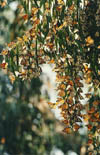The sight (and sound) of up to 100,000 monarch butterflies hanging in large clusters from the branches of a few eucalyptus trees is both inspiring and puzzling. How and why do these insects appear? The Sperling Preserve at Ellwood Mesa in Goleta is home to the Coronado Butterfly Preserve – one of the largest “over-wintering” sites for monarchs in the United States. Monarchs can travel up to 3000 miles using high-level jet streams. In the fall, the western population of US monarchs come from as far away as
But how do they find their way back to specific sites such as Ellwood? No one knows or agrees – some entomologists believe that the butterflies navigate by using the sun as a compass, some suggest that they use a magnetic compass in conjunction with an internal body clock, and some claim that they are guided by a combination of ultraviolet light detection, geographic cues, and a “biological clock.” Whatever the method, when monarchs flock by the thousands to the eucalyptus groves on the Ellwood Mesa each winter, people do the same. With this in mind, the City of Goleta established a Monarch Butterfly Docent Program to train people who are interested in giving tours and educating the general public about monarchs. One of our own Grad students, Diego Pedreros, and his 6 year old daughter, AmaRa, participated in the program this past winter: “It was a pleasure to participate in this program. It was a beautiful experience to observe the behavior of these wonderful insects and to see people’s reactions when we told them about the journey the monarchs take in order to survive. During this time, AmaRa, who enjoys playing with animals as much as talking to people, learned a lot about monarchs, and she even made a few new friends.”
Diego Pedreros is a researcher for the Climate Hazard Group and now a grad student in the MA/PHD program in Geography. The emphasis of his research is on the implications of climate variability to food security issues. Diego’s wife, Veronica Montes, is also a grad student, in the Sociology Department, focusing on the impact of transnational migration on the family structure.




